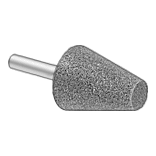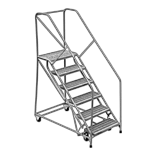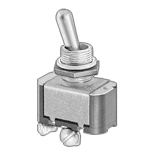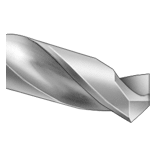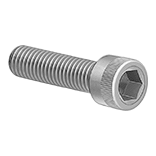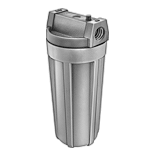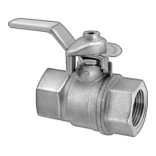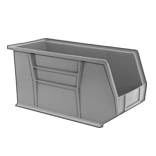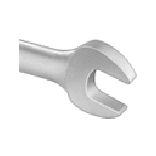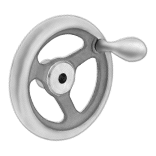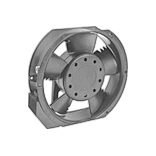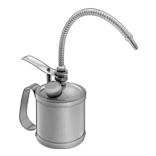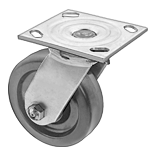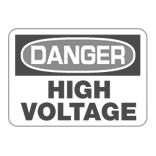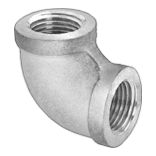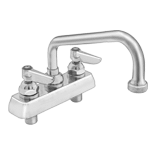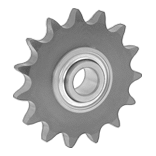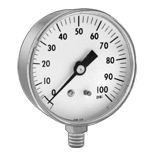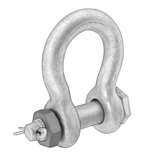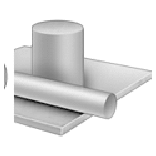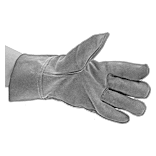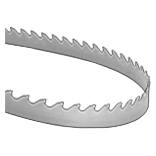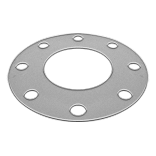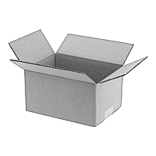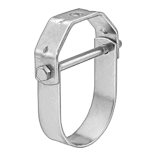Compare over 25 types of plastic to find the right material for you.
Clear Scratch- and UV-Resistant Acrylic Sheets and Bars
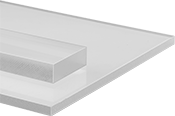
Often used for windows, signs, and windshields, these extruded acrylic sheets and bars offer nearly the same performance as cast acrylic at a lower price. They’re a better choice for outdoor use than polycarbonate because they are UV and scratch resistant and will maintain clarity over time.
Matte sheets have a nonglare finish on one side; the other side is glossy.
- Color: Clear
- Temperature Range: 32° to 160° F
- Tensile Strength: 9,195-11,030 psi (Good)
- Impact Strength: 0.040 ft.-lbs./in. (Poor)
- Hardness: Rockwell M89-M96 (Hard)
- For Use Outdoors: Yes
- Specifications Met: UL 94 HB
| Thick. | Thick. Tolerance | Appearance | Each | |
12" × 12" | ||||
|---|---|---|---|---|
| 1/16" | -0.009" to 0.004" | __ | 0000000 | 00000 |
| 5/64" | -0.006" to 0.01" | __ | 0000000 | 0000 |
| 3/32" | -0.004" to 0.016" | __ | 0000000 | 0000 |
| 1/8" | -0.019" to 0.019" | Matte×Glossy | 0000000 | 00000 |
| 1/8" | -0.013" to 0" | __ | 0000000 | 0000 |
| 3/16" | -0.02" to 0" | __ | 0000000 | 0000 |
| 1/4" | -0.026" to 0" | __ | 0000000 | 00000 |
| 3/8" | -0.038" to 0.038" | __ | 00000000 | 00000 |
12" × 24" | ||||
| 1/16" | -0.009" to 0.004" | __ | 0000000 | 0000 |
| 5/64" | -0.006" to 0.01" | __ | 0000000 | 00000 |
| 3/32" | -0.004" to 0.016" | __ | 0000000 | 00000 |
| 1/8" | -0.013" to 0" | __ | 0000000 | 00000 |
| 3/16" | -0.02" to 0" | __ | 0000000 | 00000 |
| 1/4" | -0.026" to 0" | __ | 0000000 | 00000 |
| 3/8" | -0.038" to 0.038" | __ | 00000000 | 00000 |
12" × 48" | ||||
| 1/16" | -0.009" to 0.004" | __ | 00000000 | 00000 |
| 5/64" | -0.006" to 0.01" | __ | 00000000 | 00000 |
| 1/8" | -0.013" to 0" | __ | 00000000 | 00000 |
| 1/4" | -0.026" to 0" | __ | 00000000 | 00000 |
| 3/8" | -0.038" to 0.038" | __ | 00000000 | 00000 |
24" × 24" | ||||
| 1/16" | -0.009" to 0.004" | __ | 0000000 | 00000 |
| 5/64" | -0.006" to 0.01" | __ | 0000000 | 00000 |
| 3/32" | -0.004" to 0.016" | __ | 0000000 | 00000 |
| 1/8" | -0.019" to 0.019" | Matte×Glossy | 0000000 | 00000 |
| 1/8" | -0.013" to 0" | __ | 0000000 | 00000 |
| 3/16" | -0.02" to 0" | __ | 0000000 | 00000 |
| 1/4" | -0.026" to 0" | __ | 0000000 | 00000 |
| 3/8" | -0.038" to 0.038" | __ | 00000000 | 00000 |
24" × 48" | ||||
| 1/16" | -0.009" to 0.004" | __ | 0000000 | 00000 |
| 5/64" | -0.006" to 0.01" | __ | 0000000 | 00000 |
| 3/32" | -0.004" to 0.016" | __ | 0000000 | 00000 |
| 1/8" | -0.013" to 0" | __ | 0000000 | 00000 |
| 3/16" | -0.02" to 0" | __ | 0000000 | 00000 |
| 1/4" | -0.026" to 0" | __ | 0000000 | 00000 |
| 3/8" | -0.038" to 0.038" | __ | 00000000 | 000000 |
48" × 48" | ||||
| 1/16" | -0.009" to 0.004" | __ | 00000000 | 00000 |
| 5/64" | -0.006" to 0.01" | __ | 00000000 | 00000 |
| 3/32" | -0.004" to 0.016" | __ | 00000000 | 00000 |
| 1/8" | -0.013" to 0" | __ | 00000000 | 00000 |
| 3/16" | -0.02" to 0" | __ | 00000000 | 000000 |
| 1/4" | -0.026" to 0" | __ | 00000000 | 000000 |
| 3/8" | -0.038" to 0.038" | __ | 00000000 | 000000 |
48" × 96" | ||||
| 1/16" | -0.009" to 0.004" | __ | 0000000 | 000000 |
| 5/64" | -0.006" to 0.01" | __ | 0000000 | 000000 |
| 3/32" | -0.004" to 0.016" | __ | 0000000 | 000000 |
| 1/8" | -0.019" to 0.019" | Matte×Glossy | 0000000 | 000000 |
| 1/8" | -0.013" to 0" | __ | 0000000 | 000000 |
| 3/16" | -0.02" to 0" | __ | 0000000 | 000000 |
| 1/4" | -0.026" to 0" | __ | 0000000 | 000000 |
| 3/8" | -0.038" to 0.038" | __ | 00000000 | 000000 |
- Color: Clear
- Temperature Range: 40° to 150° F
- Tensile Strength: 9,195-11,030 psi (Good)
- Impact Strength: 0.040 ft.-lbs./in. (Poor)
- Hardness: Rockwell M89-M96 (Hard)
- For Use Outdoors: Yes
| Thick. | Thick. Tolerance | Wd. | Wd. Tolerance | Lg., ft. | Each | |
| 1/8" | -0.015" to 0.015" | 1/8" | -0.015" to 0.015" | 6 | 0000000 | 00000 |
| 1/8" | -0.005" to 0.005" | 3/8" | -0.01" to 0.01" | 6 | 0000000 | 0000 |
| 1/8" | -0.005" to 0.005" | 1/2" | -0.015" to 0.015" | 6 | 0000000 | 0000 |
| 1/8" | -0.005" to 0.005" | 5/8" | -0.015" to 0.015" | 6 | 0000000 | 0000 |
| 3/16" | -0.019" to 0.019" | 1" | -0.03" to 0.03" | 6 | 0000000 | 00000 |
| 3/16" | -0.015" to 0.015" | 1/2" | -0.02" to 0.02" | 6 | 0000000 | 0000 |
| 3/16" | -0.015" to 0.015" | 3/4" | -0.025" to 0.025" | 6 | 0000000 | 00000 |
| 3/16" | -0.01" to 0.01" | 3/16" | -0.01" to 0.01" | 6 | 0000000 | 0000 |
| 1/4" | -0.015" to 0.015" | 1/4" | -0.015" to 0.015" | 6 | 0000000 | 0000 |
| 1/4" | -0.015" to 0.015" | 1/2" | -0.015" to 0.015" | 6 | 0000000 | 00000 |
| 3/8" | -0.015" to 0.015" | 3/8" | -0.015" to 0.015" | 6 | 0000000 | 0000 |
| 1/2" | -0.015" to 0.015" | 1/2" | -0.015" to 0.015" | 6 | 0000000 | 00000 |
| 3/4" | -0.015" to 0.015" | 3/4" | -0.015" to 0.015" | 6 | 0000000 | 00000 |
| 1" | -0.015" to 0.015" | 1" | -0.015" to 0.015" | 6 | 0000000 | 00000 |
Clear High-Strength Scratch- and UV-Resistant Acrylic
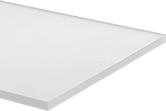
- Color: Clear
- Temperature Range: 32° to 170° F
- Tensile Strength: 8,000 psi (Good)
- Impact Strength: 0.7 ft.-lbs./in. (Poor)
- Hardness: Rockwell M68 (Hard)
- For Use Outdoors: Yes
- Specifications Met: UL 94 HB
Modified for increased impact strength over other types of acrylic, these extruded acrylic sheets are often used for skylights and outdoor signs. This material is a better choice for outdoor use than polycarbonate because it is scratch and UV resistant, and it maintains clarity over time.
| Thick. | Thick. Tolerance | Each | |
6" × 6" | |||
|---|---|---|---|
| 1/16" | -0.009" to 0.004" | 0000000 | 00000 |
| 5/64" | -0.006" to 0.01" | 0000000 | 0000 |
| 3/32" | -0.01" to 0.009" | 0000000 | 0000 |
| 7/64" | -0.003" to 0.021" | 0000000 | 0000 |
| 1/8" | -0.013" to 0.013" | 0000000 | 0000 |
| 3/16" | -0.029" to 0.008" | 0000000 | 0000 |
| 7/32" | -0.021" to 0.023" | 0000000 | 0000 |
| 1/4" | -0.025" to 0.025" | 0000000 | 0000 |
| 23/64" | -0.041" to 0.031" | 0000000 | 0000 |
| 3/8" | -0.038" to 0.038" | 00000000 | 0000 |
| 1/2" | -0.05" to 0.05" | 0000000 | 0000 |
12" × 6" | |||
| 1/16" | -0.009" to 0.004" | 0000000 | 0000 |
| 5/64" | -0.006" to 0.01" | 0000000 | 0000 |
| 3/32" | -0.01" to 0.009" | 0000000 | 0000 |
| 7/64" | -0.003" to 0.021" | 0000000 | 0000 |
| 1/8" | -0.013" to 0.013" | 0000000 | 0000 |
| 3/16" | -0.029" to 0.008" | 0000000 | 0000 |
| 7/32" | -0.021" to 0.023" | 0000000 | 0000 |
| 1/4" | -0.025" to 0.025" | 0000000 | 0000 |
| 23/64" | -0.041" to 0.031" | 0000000 | 00000 |
| 3/8" | -0.038" to 0.038" | 00000000 | 00000 |
| 1/2" | -0.05" to 0.05" | 0000000 | 00000 |
12" × 12" | |||
| 1/16" | -0.009" to 0.004" | 0000000 | 0000 |
| 5/64" | -0.006" to 0.01" | 0000000 | 0000 |
| 3/32" | -0.01" to 0.009" | 0000000 | 0000 |
| 7/64" | -0.003" to 0.021" | 0000000 | 0000 |
| 1/8" | -0.013" to 0.013" | 0000000 | 0000 |
| 3/16" | -0.029" to 0.008" | 0000000 | 00000 |
| 7/32" | -0.021" to 0.023" | 0000000 | 00000 |
| 1/4" | -0.025" to 0.025" | 0000000 | 00000 |
| 23/64" | -0.041" to 0.031" | 0000000 | 00000 |
| 3/8" | -0.038" to 0.038" | 00000000 | 00000 |
| 1/2" | -0.05" to 0.05" | 0000000 | 00000 |
24" × 24" | |||
| 1/16" | -0.009" to 0.004" | 0000000 | 00000 |
| 5/64" | -0.006" to 0.01" | 0000000 | 00000 |
| 3/32" | -0.01" to 0.009" | 0000000 | 00000 |
| 7/64" | -0.003" to 0.021" | 0000000 | 00000 |
| 1/8" | -0.013" to 0.013" | 0000000 | 00000 |
| 3/16" | -0.029" to 0.008" | 0000000 | 00000 |
| 7/32" | -0.021" to 0.023" | 0000000 | 00000 |
| 1/4" | -0.025" to 0.025" | 0000000 | 00000 |
| 23/64" | -0.041" to 0.031" | 0000000 | 00000 |
| 3/8" | -0.038" to 0.038" | 00000000 | 00000 |
| 1/2" | -0.05" to 0.05" | 0000000 | 00000 |
| Thick. | Thick. Tolerance | Each | |
48" × 24" | |||
|---|---|---|---|
| 1/16" | -0.009" to 0.004" | 0000000 | 000000 |
| 5/64" | -0.006" to 0.01" | 0000000 | 00000 |
| 3/32" | -0.01" to 0.009" | 0000000 | 00000 |
| 7/64" | -0.003" to 0.021" | 0000000 | 00000 |
| 1/8" | -0.013" to 0.013" | 0000000 | 00000 |
| 3/16" | -0.029" to 0.008" | 0000000 | 00000 |
| 7/32" | -0.021" to 0.023" | 0000000 | 00000 |
| 1/4" | -0.025" to 0.025" | 0000000 | 00000 |
| 23/64" | -0.041" to 0.031" | 0000000 | 000000 |
| 3/8" | -0.038" to 0.038" | 00000000 | 000000 |
| 1/2" | -0.05" to 0.05" | 0000000 | 000000 |
48" × 48" | |||
| 1/16" | -0.009" to 0.004" | 00000000 | 00000 |
| 5/64" | -0.006" to 0.01" | 00000000 | 00000 |
| 3/32" | -0.01" to 0.009" | 00000000 | 00000 |
| 7/64" | -0.003" to 0.021" | 00000000 | 00000 |
| 1/8" | -0.013" to 0.013" | 00000000 | 00000 |
| 3/16" | -0.029" to 0.008" | 00000000 | 000000 |
| 7/32" | -0.021" to 0.023" | 00000000 | 000000 |
| 1/4" | -0.025" to 0.025" | 00000000 | 000000 |
| 23/64" | -0.041" to 0.031" | 00000000 | 000000 |
| 3/8" | -0.038" to 0.038" | 00000000 | 000000 |
| 1/2" | -0.05" to 0.05" | 00000000 | 000000 |
60" × 48" | |||
| 1/16" | -0.009" to 0.004" | 00000000 | 000000 |
| 5/64" | -0.006" to 0.01" | 00000000 | 000000 |
| 3/32" | -0.01" to 0.009" | 00000000 | 000000 |
| 7/64" | -0.003" to 0.021" | 00000000 | 000000 |
| 1/8" | -0.013" to 0.013" | 00000000 | 000000 |
| 3/16" | -0.029" to 0.008" | 00000000 | 000000 |
| 7/32" | -0.021" to 0.023" | 00000000 | 000000 |
| 1/4" | -0.025" to 0.025" | 00000000 | 000000 |
| 23/64" | -0.041" to 0.031" | 00000000 | 000000 |
| 3/8" | -0.038" to 0.038" | 00000000 | 000000 |
| 1/2" | -0.05" to 0.05" | 00000000 | 000000 |
96" × 48" | |||
| 1/16" | -0.009" to 0.004" | 0000000 | 000000 |
| 5/64" | -0.006" to 0.01" | 0000000 | 000000 |
| 3/32" | -0.01" to 0.009" | 0000000 | 000000 |
| 7/64" | -0.003" to 0.021" | 0000000 | 000000 |
| 1/8" | -0.013" to 0.013" | 0000000 | 000000 |
| 3/16" | -0.029" to 0.008" | 0000000 | 000000 |
| 7/32" | -0.021" to 0.023" | 0000000 | 000000 |
| 1/4" | -0.025" to 0.025" | 0000000 | 000000 |
| 23/64" | -0.041" to 0.031" | 0000000 | 000000 |
| 3/8" | -0.038" to 0.038" | 00000000 | 000000 |
| 1/2" | -0.05" to 0.05" | 0000000 | 000000 |
Easy-to-Form PVC/Acrylic
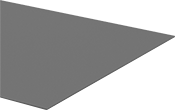
- Color: See table
- Temperature Range: -40° to 150° F
- Tensile Strength: 6,100 psi (Good)
- Impact Strength: 15 ft.-lbs./in. (Excellent)
- Hardness: Rockwell R94 (Hard)
- For Use Outdoors: No
- Specifications Met: UL 94 V-0
Widely used for vehicle interiors and equipment housings, these sheets maintain their physical properties after thermoforming. They resist many corrosive chemicals and cleaning solutions. One side is smooth; the other side has a coarse texture to mask scratches, scuffs, and fingerprints. This material is comparable to Kydex.
| Thick. | Thick. Tolerance | Choose a Color | Each | |
12" × 12" | ||||
|---|---|---|---|---|
| 1/8" | -0.009" to 0.009" | 0000000 | 000000 | |
| 3/16" | -0.013" to 0.013" | 0000000 | 00000 | |
| 1/4" | -0.018" to 0.018" | 0000000 | 00000 | |
12" × 24" | ||||
| 1/8" | -0.009" to 0.009" | 0000000 | 00000 | |
| 3/16" | -0.013" to 0.013" | 0000000 | 00000 | |
| 1/4" | -0.018" to 0.018" | 0000000 | 00000 | |
24" × 48" | ||||
| 1/8" | -0.009" to 0.009" | 0000000 | 00000 | |
| 3/16" | -0.013" to 0.013" | 0000000 | 000000 | |
| 1/4" | -0.018" to 0.018" | 0000000 | 000000 | |
48" × 48" | ||||
| 1/8" | -0.009" to 0.009" | 0000000 | 000000 | |
| 3/16" | -0.013" to 0.013" | 0000000 | 000000 | |
| 1/4" | -0.018" to 0.018" | 0000000 | 000000 | |
48" × 96" | ||||
| 1/8" | -0.009" to 0.009" | 0000000 | 000000 | |
| 3/16" | -0.013" to 0.013" | 0000000 | 000000 | |
| 1/4" | -0.018" to 0.018" | 0000000 | 000000 | |
Mirrored Scratch-Resistant Acrylic Sheets
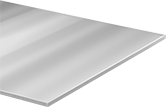
Resistant to scuffs and scratches, these mirrored acrylic sheets are a lightweight alternative to mirrored glass. One side is coated with aluminum for a highly reflective finish.
- Temperature Range: 32° to 160° F
- Tensile Strength: 10,000-11,030 psi (Good)
- Impact Strength: 0.4 ft.-lbs./in. (Poor)
- Hardness: Rockwell M93-M95 (Hard)
- For Use Outdoors: Yes
- Specifications Met: UL 94 HB
| Thick. | Thick. Tolerance | Each | |
3" × 24" | |||
|---|---|---|---|
| 1/8" | -0.019" to 0.005" | 0000000 | 00000 |
| 1/4" | -0.038" to 0.01" | 0000000 | 00000 |
6" × 6" | |||
| 1/8" | -0.019" to 0.005" | 0000000 | 0000 |
| 1/4" | -0.038" to 0.01" | 0000000 | 00000 |
6" × 24" | |||
| 1/8" | -0.019" to 0.005" | 0000000 | 00000 |
| 1/4" | -0.038" to 0.01" | 0000000 | 00000 |
12" × 12" | |||
| 1/8" | -0.019" to 0.005" | 0000000 | 00000 |
| 1/4" | -0.038" to 0.01" | 0000000 | 00000 |
24" × 24" | |||
| 1/8" | -0.019" to 0.005" | 0000000 | 00000 |
| 1/4" | -0.038" to 0.01" | 0000000 | 000000 |
36" × 36" | |||
| 1/8" | -0.019" to 0.005" | 0000000 | 000000 |
| 1/4" | -0.038" to 0.01" | 0000000 | 000000 |
- Temperature Range: 32° to 160° F
- Tensile Strength: 10,000-11,030 psi (Good)
- Impact Strength: 0.4 ft.-lbs./in. (Poor)
- Hardness: Rockwell M93-M95 (Hard)
- For Use Outdoors: Yes
| Thick. | Thick. Tolerance | Adhesive Type | Adhesive Temperature, °F | Each | |
3" × 24" | |||||
|---|---|---|---|---|---|
| 1/8" | -0.019" to 0.005" | Rubber | 32° to 150° | 00000000 | 000000 |
| 1/4" | -0.038" to 0.01" | Rubber | 32° to 150° | 00000000 | 00000 |
6" × 6" | |||||
| 1/8" | -0.019" to 0.005" | Rubber | 32° to 150° | 0000000 | 0000 |
| 1/4" | -0.038" to 0.01" | Rubber | 32° to 150° | 0000000 | 00000 |
6" × 24" | |||||
| 1/8" | -0.019" to 0.005" | Rubber | 32° to 150° | 00000000 | 00000 |
| 1/4" | -0.038" to 0.01" | Rubber | 32° to 150° | 00000000 | 00000 |
12" × 12" | |||||
| 1/8" | -0.019" to 0.005" | Rubber | 32° to 150° | 0000000 | 00000 |
| 1/4" | -0.038" to 0.01" | Rubber | 32° to 150° | 0000000 | 00000 |
24" × 24" | |||||
| 1/8" | -0.019" to 0.005" | Rubber | 32° to 150° | 00000000 | 00000 |
| 1/4" | -0.038" to 0.01" | Rubber | 32° to 150° | 00000000 | 000000 |
36" × 36" | |||||
| 1/8" | -0.019" to 0.005" | Rubber | 32° to 150° | 00000000 | 000000 |
| 1/4" | -0.038" to 0.01" | Rubber | 32° to 150° | 00000000 | 000000 |
